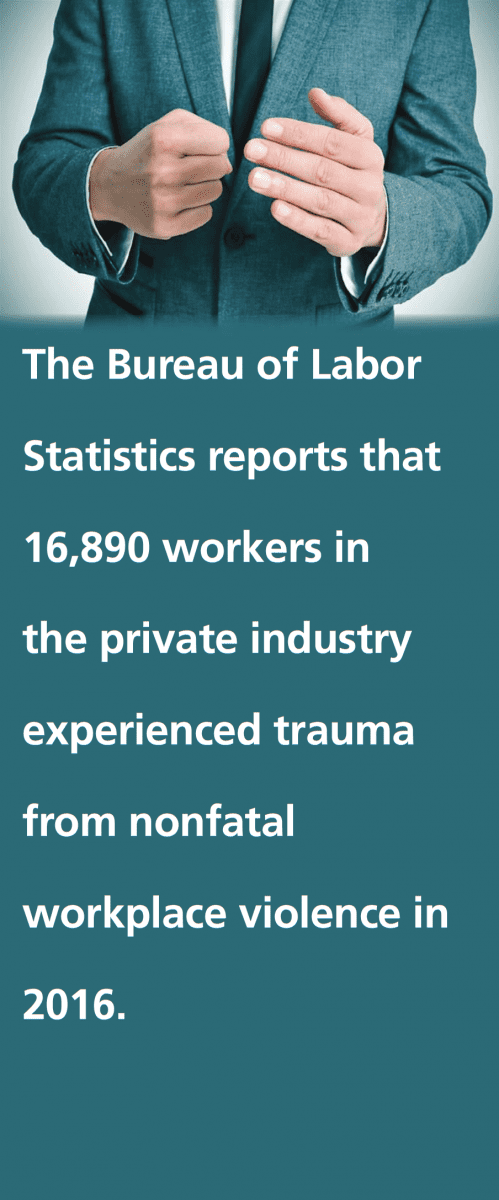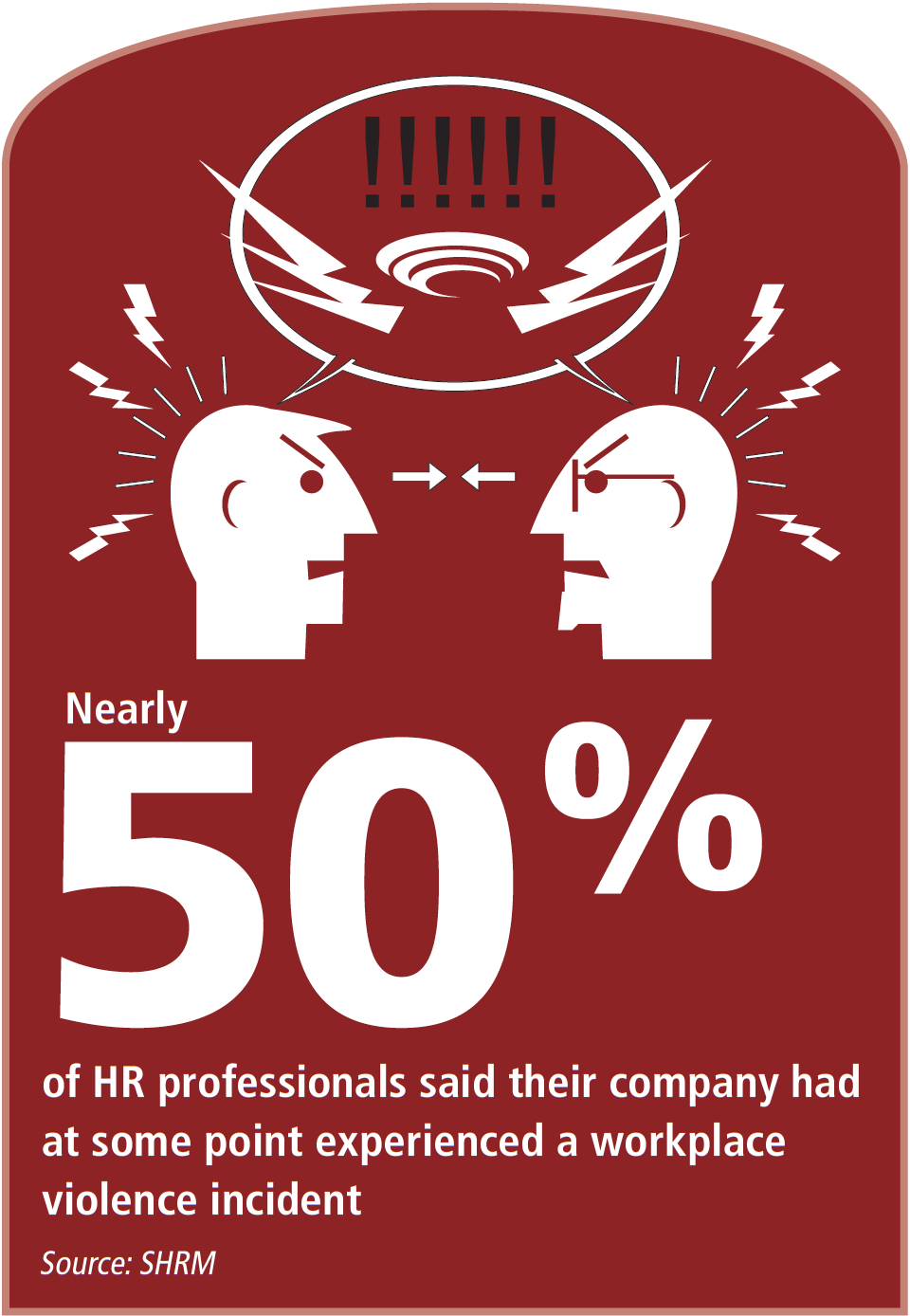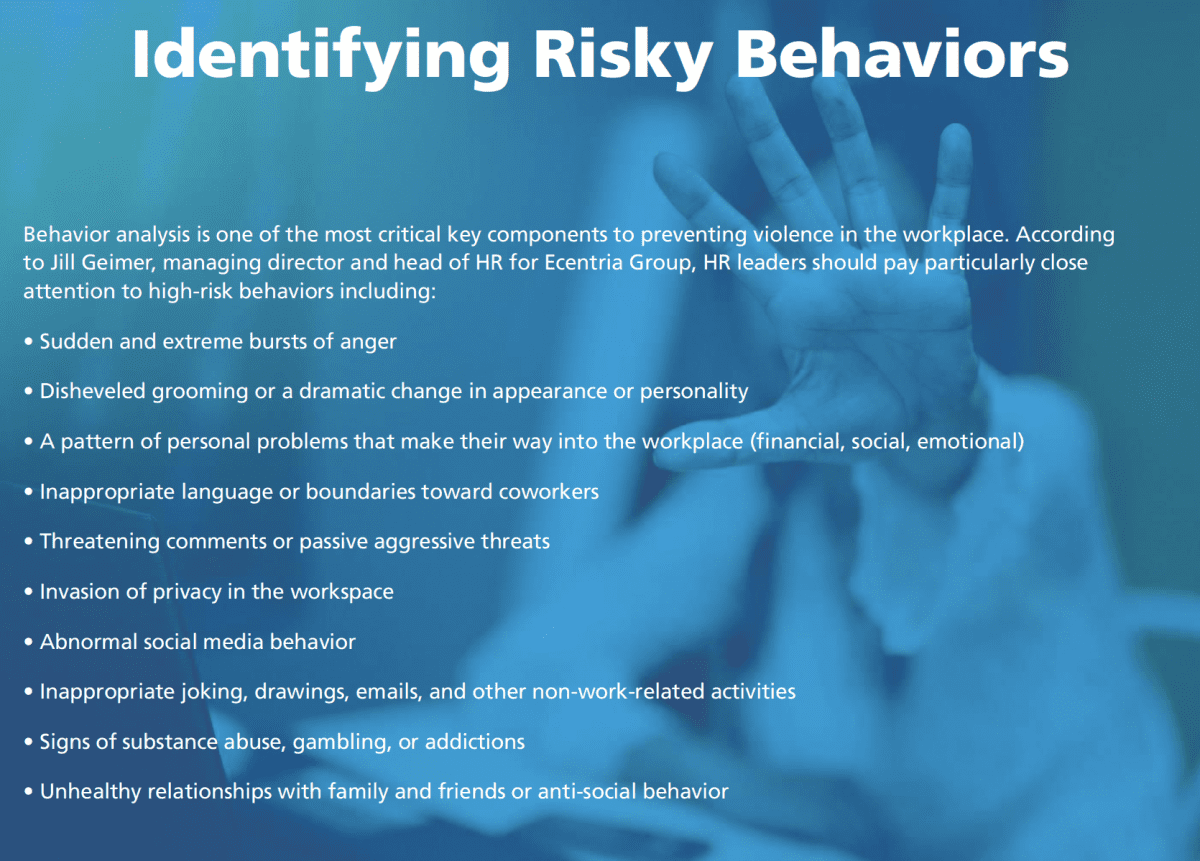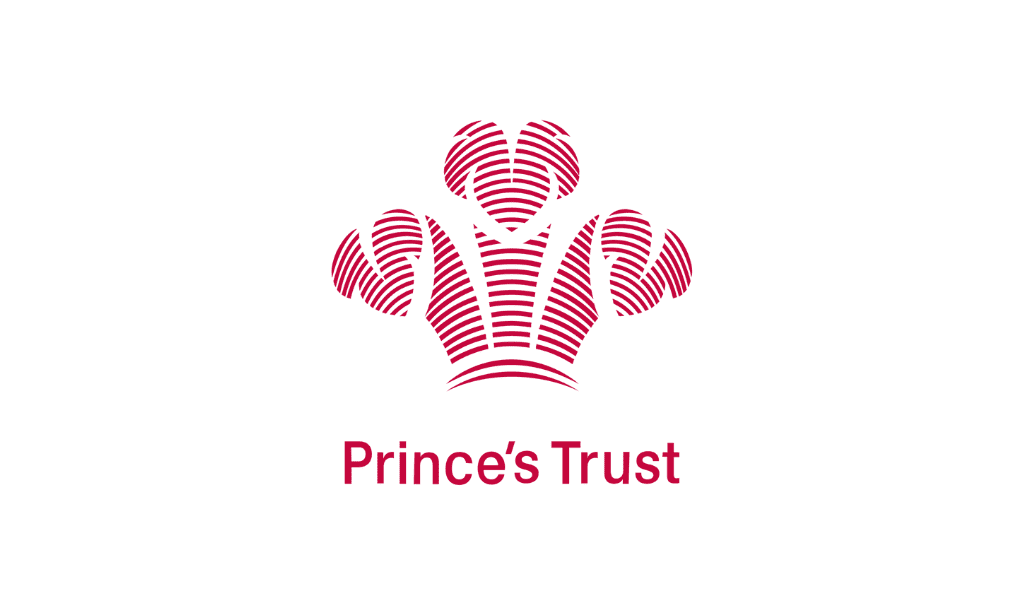Workplace violence is on the rise, but a safety policy that addresses security, culture, and management can help mitigate the risk.
By Marta Chmielowicz
For Jill Geimer and many other HR executives, February 15, 2019 is a day that will be hard to forget. According to reports from The Washington Post, after being terminated from his position at Henry Pratt manufacturing company in Aurora, Ill., employee Gary Martin opened fire, killing five people and wounding six others. This hit particularly close to home for Geimer, whose company, Ecentria Group, houses a large inventory warehouse in the region.
“We have 100 warehouse workers, a smaller group of warehouse-trained managers, and two HR people onsite at the warehouse,” says the managing director and head of HR for Ecentria Group, an online retailer of outdoor gear, hunting accessories, and military equipment. “I was sitting at my desk in February and we received news that there was an active shooter situation in a warehouse in Aurora. We all tuned into the news coverage and they weren’t saying the name of the warehouse or the company. It was a heart-stopping moment and we reached out as quickly as we could to our employees. We were able to identify that it was not our location, but it was right down the road.”
The shooting was a wake-up call. In response, the company doubled down on its security measures in preparation for a significant upcoming staff restructuring initiative. According to Geimer, the HR team was careful to avoid several of the risk factors of violence by implementing these best practices:
- Terminations were conducted in small groups arranged by department rather than unmanageably large groups or individual meetings.
- Meetings were kept completely confidential with only top executives prepped in advance.
- Security guards were hired, given floor plans, and stationed in specific areas to closely monitor the situation. Cameras, facilities, and parking lot procedures were also reviewed.
- Meetings were conducted close to the front door and terminated employees were immediately escorted out of the office with their building access revoked.
- Police officers were alerted to potential threats by specific employees.
- Terminated employees’ concerns were only addressed after the weekend, once the intensity of their communication subsided.

These types of precautions are a safe and smart route to take considering that the Henry Pratt tragedy could have occurred in any organization. According to SHRM’s 2019 Workplace Violence study, nearly half of HR professionals said their company had at some point experienced a workplace violence incident -up from 36 percent in 2012. And of those who reported having experienced workplace violence, over half said the incident occurred in the last year. Furthermore, the Bureau of Labor Statistics reports that 16,890 workers in the private industry experienced trauma from nonfatal workplace violence in 2016, and in the same year, 500 employees were the victims of workplace homicides -an increase of 83 cases from 2015.
But is it the job of HR professionals to prevent these violent situations from occurring? Ian D. Meklinsky, attorney at law and co-chair of the labor and employment department at Fox Rothschild LLP, reports that employers have a legal responsibility to secure the safety of their employees under negligence law and the Occupational Safety and Health Administration (OSHA)’s general duty clause. According to the former, organizations can get sued for damages related to an injury if they fail to act on a known threat. Similarly, the OSHA general duty clause, Section 5(a)(1) of the Occupational Safety and Health Act, requires that employers provide a workplace that is free from hazards that may cause death or serious physical harm. Failure to do so can result in an inspection, citation, penalty, or even criminal sanctions.
Securing the Workplace
These termination procedures are merely one component of Ecentria Group’s broader “Violence in the Workplace and Emergency Prevention Plan,” which also includes background screening and reference checks; real-time cell phone alerts; evacuation drills; manager training sessions; and more. By introducing a formal, structured workplace violence policy that addresses security, culture, and management considerations, the company has succeeded in creating a safe space for all employees.
Organizations that wish to develop a similar approach to workplace violence prevention should implement these essential practices:
1. Keep an eye on security. Every organization should have a delineated workplace violence policy and a well-known action plan in case of an emergency. These should be communicated to employees through regular safety training sessions.
“Workplace safety training and policies mitigate the threat of violence,” says Nikki Harland, senior vice president of HR at Paradies Lagardère, a travel retailer that operates in airports across the country. “We also have a loss prevention team that focuses on safety. When they are in the field, they are talking about emergency evacuations for acts of God or violent situations so that folks know where to go and how to remove themselves from a setting that is unsafe. That is something that is frequently discussed, updated, and documented. Across all of our airports, hazardous materials, fires, and gun violence are things that we openly talk about.”
According to Harland, these training sessions always reference specific language contained within the written anti-violence policy. The company also makes sure that the leadership team frequently reiterates the policy, tools, and resources available to employees in order to reassure them that the organization can respond adequately to an emergency.
In addition to developing a concrete safety policy, Meklinsky also emphasizes the importance of maintaining the security of interior spaces by conducting regular surveys of the facilities. He recommends that employers:
- assess the accessibility of entrance and exit points;
- ensure that there are adequate means of internal and external communication;
- leverage technologies like swipe keys, security cameras, and buzz-in systems; and
- provide training on evacuation plans under the guise of fire prevention.
2. Encourage an open and transparent culture. Another element of a safe and healthy workplace is a culture where employees feel comfortable sharing their concerns if they feel threatened or uneasy -whether it’s by a coworker or by an event in their own life.
Creating this type of environment can be a challenge because sometimes, the problems that affect work performance are deeply personal. For example, Geimer shared a story of an employee who was experiencing a painful divorce and receiving frequent threatening calls to the office from her ex-husband. This employee felt that discussing the threat breached the boundaries of professionalism, so it was up to Geimer to listen to circulating rumors, approach the employee at the appropriate moment, and propose an action plan.

For this approach to work, employees need to be comfortable bringing concerns about their coworkers to the attention of managers. According to Meklinsky, this is especially difficult in unionized environments where individuals can face significant consequences for “turning in” their coworkers. “You have to get your employees on board so that they understand that they are part of a team -and part of that is identifying problems in the workplace,” he says.
Meklinsky recommends that organizations include an anti-retaliation provision in their workplace safety policy so that employees are not penalized for their attempts to report suspicious behaviors. Likewise, Geimer says that a policy should include a “duty to report” clause in which all employees are required to report any unsettling behavior on behalf of a coworker or external person who could pose a threat to the workplace.
“A 24-hour, private phone number to report concerns should be set up as well as an ‘HR Box’ in which employees can privately put a typed, anonymous note,” Geimer explains. “These should be checked and monitored several times a day.”
Leveraging neutral, third-party outlets like employee assistance programs (EAPs) also allows employees to anonymously come forward to discuss their problems. These and other resource groups are offered by both Ecentria and Paradies Legardère as a way to provide employees with financial and emotional support in periods of stress.
3. Train management to react appropriately. Managers play an essential role in monitoring employees for risky and threatening behaviors. A culture of openness cannot exist if managers do not pay attention to their employees’ needs and create a safe space where their people feel heard and respected.
“I think employers need to monitor the workplace and take note of employees whose behavior has markedly changed,” says Meklinsky. This might include employees who are lashing out, retreating as loners, or becoming increasingly difficult and hostile toward others. According to Geimer, managers should also pay close attention to other signs of mental health deterioration such as increasingly disheveled appearance, abnormal or aggressive social media behavior, and inappropriate boundaries with coworkers.
Geimer recommends that organizations leverage ongoing performance management tools as a way to keep track of these behaviors and create a written record of performance that can be consulted if employees begin to exhibit any strange or suspicious patterns. At Ecentria, employees, managers, and HR leaders all engage in a consistent dialogue about employee performance via a single platform, making any sudden changes or inconsistencies in performance very apparent.
But employers also need to be trained on how to recognize these signs and appropriately engage the employee of concern or reach out to coworkers for further intel. Geimer says that offering training that focuses on behavioral analysis can help managers build confidence, especially when dealing with employees who are exhibiting risky behaviors like inappropriate language and passive-aggressive threats (see Identifying Risky Behaviors for more).
4. Periodically reevaluate workplace safety policies. While following these best practices will allow organizations to create a culture that values workplace safety, it’s important that leaders constantly reevaluate their workplace safety policies to deal with any new threats. “We think our process and policies are iron solid, but if there’s a new threat that’s presenting itself, we evaluate how strong we are in that space,” says Harland. “If we’re not, we update at that point -we don’t wait a year to do that. If we hear about different things that can affect our environment, we’re constantly talking with our loss prevention team to make sure that we are covered. That’s an informal process -I can read something in the news and we can immediately react as a leadership team.”
With a growing pressure to keep employees safe, HR needs to take proactive measures in order to reduce the risk of violence in the workplace.















